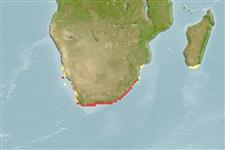>
Mugiliformes (Mullets) >
Mugilidae (Mullets)
Etymology: Pseudomyxus: Name from the genus Myxus preceeded by Greek prefix 'pseudo' meaning 'false'.
More on author: Valenciennes.
Environment: milieu / climate zone / ລະດັບຄວາມເລິກ / distribution range
ນິເວດວິທະຍາ
ສັດທະເລ; ນ້ຳຈືດ; ນ້ຳກ່ອຍ ອາໄສຢູ່ໃກ້ໜ້າດິນໃຕ້ພື້ນທ້ອງນ້ຳ; ກຸ່ມປາຫຼຊະນິດປາທີ່ມີການເຄື່ອນຍ້າຍຈາກແມ່ນ້ຳລົງສູ່ທະເລເພື່ອວ່າງໄຂ່ (Ref. 51243). Subtropical; 25°S - 35°S
Africa: endemic to South Africa, in east coastal estuaries and rivers from the Breë River to Kosi Bay (Ref. 7248, 52193).
Length at first maturity / ຂະໜາດ / ນ້ຳໜັກ / Age
ການຈະເລີນເຕັມໄວ: Lm 23.0 range ? - ? cm
Max length : 45.0 cm FL ຕົວຜູ້/ບໍ່ມີເພດ; (Ref. 52193)
ຄີ (ໜາມ)ແຂງຢູ່ຫຼັງປາ (ທັງໝົດ) : 5; ຄີຫຼັງຂອງປາ (ຄີອ່ອນ) (ທັງໝົດ) : 8; ຄີ(ໜາມ) ແຂງຢູ່ຄີກົ້ນປາ
ກຸ່ມປາກະດູກແຂງ
ຄວາມຖີ່ຂອງກຸ່ມຖ່າຍທອດພັນ
ປາທີ່ມີການເຄື່ອນຍ້າຍຈາກທະເລໄປຫານ້ຳຈືດ ແລະນ້ຳຈືດຫາທະເລ
ປາທີ່ມີການເຄື່ອນຍ້າຍຈາກທະເລແລະໄປໄຂ່ຢູ່ນ້ຳຈືດ
ຄີກົ້ນຂອງປາ
ສັດທີ່ມີກະດູກສັນຫັຼງ
ການຖ່າຍທອດທາງກຳມະພັນຈາກພໍ່ແມ່ຫາລູກ: 3; ຄີກົ້ນຂອງປາ: 9.
Body shape (shape guide): fusiform / normal.
Adults occur in freshwater to estuarine conditions. Adults breed at sea, throughout the year; juveniles move into estuaries and enter rivers usually in late winter or early spring (Ref. 52193). Females remain in freshwater for 7 years, males for 4 years (Ref. 52193). Return to estuaries before maturing sexually prior to spawning (Ref. 52193). Oviparous, eggs are pelagic and non-adhesive (Ref. 205). Feed on benthic algae and small invertebrates over muddy bottom (Ref. 6465). Decline in population from obstruction, by dams and weirs, of free passage into rivers.
Life cycle and mating behavior
ການຈະເລີນເຕັມໄວ | ການສືບພັນ | ການວາງໄຂ່ | ໄຂ່ | ຄວາມດົກຂອງໄຂ່ປາ | ຕົວອ່ອນ
Breed at the sea throughout the year. Juveniles move into estuaries and enter rivers usually in late winter or early spring. Males remain in freshwater until 4 years, females for up to 7 years. Fish return first to estuaries before maturing sexually prior to spawning (Ref. 7248).
Thomson, J.M., 1986. Mugilidae. p. 344-349. In J. Daget, J.-P. Gosse and D.F.E. Thys van den Audenaerde (eds.) Check-list of the freshwater fishes of Africa (CLOFFA). ISNB, Brussels, MRAC; Tervuren; and ORSTOM, Paris. Vol. 2. (Ref. 3573)
IUCN Red List Status (Ref. 130435: Version 2025-1)
Threat to humans
Harmless
Human uses
ການປະມົງ: ເປັນສີນຄ້າ; ຕູ້ປາ: ເປັນສີນຄ້າ
ເຄື່ອງມື
Special reports
Download XML
ແຫຼ່ງອີນເຕີເນັດ
Estimates based on models
Preferred temperature (ເອກະສານອ້າງອີງ
123201): 15.3 - 24.9, mean 22.6 °C (based on 20 cells).
Phylogenetic diversity index (ເອກະສານອ້າງອີງ
82804): PD
50 = 1.0000 [Uniqueness, from 0.5 = low to 2.0 = high].
Bayesian length-weight: a=0.01175 (0.00668 - 0.02065), b=2.97 (2.82 - 3.12), in cm total length, based on LWR estimates for this species & (Sub)family-body (Ref.
93245).
ຊັ້ນເຂດຮ້ອນ (ເອກະສານອ້າງອີງ
69278): 2.8 ±0.27 se; based on food items.
ຄວາມຢືດຢຸ່ນ (ເອກະສານອ້າງອີງ
120179): ຂະໜາດກາງ, ປະຊາກອນຕຳ່ສຸດທີ່ໃຊ້ເວລາສອງເທົ່າ 1.4 - 4.4 ປີ (Preliminary K or Fecundity.).
Fishing Vulnerability (Ref.
59153): Moderate vulnerability (40 of 100).
🛈
